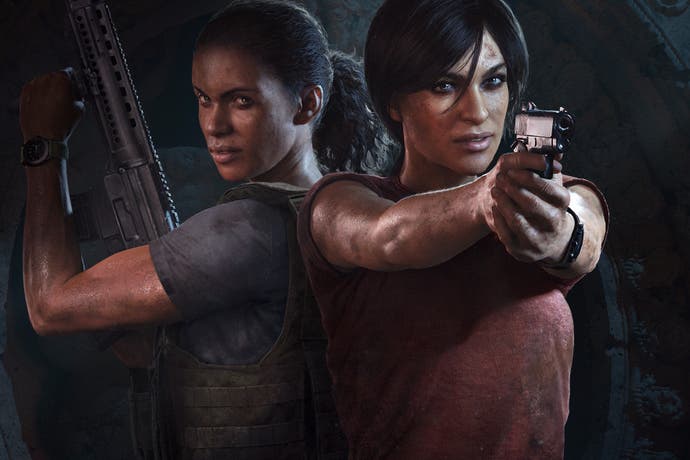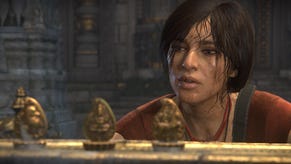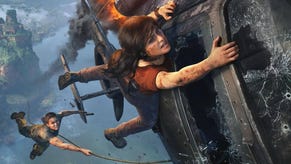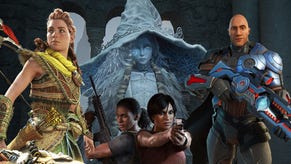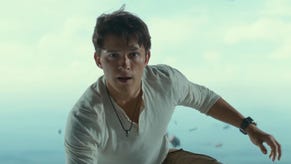The Lost Legacy is Uncharted meets MGS5 - and it works
UPDATED: Digital Foundry's gameplay analysis is joined by a comparison of the final code against the initial reveal.
UPDATE 20/8/17 3:20pm: We've updated this article with a comparison video showing how the final version of The Lost Legacy compares with the title's debut trailer. You can find the video a little further down the page.
Original story: Just a little over one year after the release of Uncharted 4, Naughty Dog has returned with a new, slimmer entry in the franchise. With a change in protagonist and a new location, Uncharted: The Lost Legacy offers a taste of both old and new. Nathan Drake's globe-trotting adventures are replaced with a less expansive, single-location story but there's a strong argument that the gameplay is now wider as a result. The series' signature linear storytelling is melded with more pronounced infiltration, stealth and exploration elements set within a larger gameplay area, so in this sense, Uncharted has incorporated mechanics reminiscent of Metal Gear Solid 5 and even Crysis. The good news is that the evolution in the approach really pays off.
To a certain extent, this is a consequence of the nature of The Lost Legacy itself - it's a different type of production. Starting life as a simple piece of DLC, Naughty Dog's latest has evolved into a full-blown standalone Uncharted adventure, but this faster production also brings along a different approach to the series than we've seen in the past, and a different way of exploiting the team's state-of-the-art technology. In fact, you might argue that The Lost Legacy is in some ways a prototype for what an open world Uncharted game might be.
Once you break free from the linear, action-packed introduction sequence, you're dropped into a vast Indian ruin on the hunt for treasure. Uncharted 4 previously included a similar section that has Drake and friends driving a jeep around Madagascar, but The Lost Legacy takes things further by offering multiple objectives that can be visited in any order, alongside enemy fortifications and bonus quests. It's in this sense that the new Uncharted integrates some aspects of MGS5, though it is worth noting that in this adventure, the map isn't anywhere near as vast as the Kojima classic.
However, the new design pushes aspects of Naughty Dog's technology further than before, with a map larger than anything we've experienced in previous series entries. And despite this, map density is on par with the most richly detailed areas in Uncharted 4. It's this sense of scale that provides the greatest sense of change: Naughty Dog itself has confirmed that the game lacks any significant changes to underlying renderer but it feels fresh because of its size and because of the tasks the developer sets for the player.
Naughty Dog's focus on a single location also pays off beautifully. Without the globetrotting element, the adventure winds up feeling more cohesive, a feeling not unlike the original Drake's Fortune. India is rich with dense foliage peppering the terrain while intricate stonework acts as a framework for the game's temples. You'll go from beautiful scenes with crystal clear water that warps and reacts to each step to muddy rain soaked parallax occlusion map-enabled terrain where realistic footprints are left behind as you move through it.
Looking at the range of technology available to the developer, The Lost Legacy makes extensive use of the techniques available resulting in a compelling, immersive experience. Foliage reacts realistically as you move through it while puffs of smoke accept surrounding shadows. Texture work remains highly refined from the richly detailed mud and stone textures used across the ruins to the depiction of skin and fabric - the quality is on par with Uncharted 4 itself.
The more urban locations are also rich in incidental detail as well, with hundreds of tiny trinkets placed around every scene. Even with its shorter development cycle, the eye for detail remains impressive. Another aspect that helps bring everything together is the lighting: from the moody city streets to the atmospheric ruins, Uncharted continues to offer realistic, yet stylised lighting throughout. Bounce lighting is taken into account here as well, repurposing Uncharted 4's uncanny pre-calculated global illumination techniques, while Naughty Dog's beautiful volumetric lighting is also put to good use here, enabling some beautiful scenes as light shafts slice through the scene. Altogether, there's little doubt that The Lost Legacy is an stunning title. You may be surprised to learn that the technology powering it hasn't really evolved in any significant fashion since the previous game, according to Naughty Dog itself. For the next-gen tech, we'll have to wait until The Last of Us Part 2.
So, what's the score with PS4 and PS4 Pro platform comparisons? In many ways, it's a re-run of Uncharted 4, as you might expect. The developer hands in state-of-the-art image quality on both systems thanks to an excellent temporal anti-aliasing solution that all but eliminates shimmering and jagged edges. The base PS4 delivers a native 1080p, but the situation on Pro is less clear. A ballpark 1440p is our best estimate here, but pixel-counting produces variable counts. It averages out to around 1440p as expected, but some areas came up with results beyond this, while others were below. It's difficult to say if we're looking at a dynamic resolution here or if it's simply a case of post-processing passes or temporal AA interfering with pixel-counting. Either way, the end result is still an improved presentation on 4K screens, virtually artefact-free but a touch soft owing to the inevitable upscaling, and downsampling is supported for users with 1080p displays.
Beyond that though, there are no improvements for Pro owners. It's an interesting situation - on the one hand, it's great that users of all consoles enjoy a similar experience, but on the other, the PS4 Pro implementation doesn't feel as robust or as ambitious as other games, such as Horizon Zero Dawn. Without knowing where the bottlenecks lie, it's difficult to say how much further it could be pushed, but The Last of Us Part 2 should show us what Naughty Dog is truly capable of with the Pro - the enhanced tech can be architected with the machine in mind.
Performance-wise, it's mostly good news. Both systems deliver a locked, properly frame-paced 30 frames per second for the vast majority of the game's duration. Certain gameplay scenarios that are heavy with rain, foliage and other transparency effects can cause The Lost Legacy to dip beneath its target frame-rate, but generally, slow-down is extremely rare - which does make it all the more noticeable when it does actually kick in. For a single-player focused game like Uncharted, this is a solid level of performance that balances pretty graphics with stable frame-rate and it works well whether you're using a PS4 or a PS4 Pro.
We couldn't test multiplayer due to the title's current pre-release status and lack of players, but we did play some survival - a mode added to Uncharted 4 late last year. Unlike the competitive mode, this is limited to 30 frames per second, just like the campaign. As an AI-focused wave mode, this comes as no great surprise, but what is surprising is the resolution. On the standard PS4, survival is bumped up to 1080p compared to competitive mode's 900p resolution. On PS4 Pro, however, survival is also limited to just 1080p, rather than supporting higher resolutions as we see in single player - a bit disappointing for Pro users.
Ultimately, The Lost Legacy is an interesting experiment that offers the best ratio of development time to gameplay length the studio has delivered yet. Sure, that's a rather strange metric to judge by but we're accustomed to waiting a long time for each new Naughty Dog project. At the same time, it's easy to see how this was produced in a shorter time frame since it lacks a lot of the more bombastic moments we saw in Uncharted 4. Reducing the emphasis on the series' signature set-pieces may be a factor of both a smaller budget and a shorter development time, but what's fascinating here is how Naughty Dog has pivoted towards new directions in game design to compensate.
The change in pacing and flow are fascinating and in some ways, the map design feels more like Crysis than a typical open world - and that's a good thing. It's still relatively constrained but there's plenty of freedom when approaching each scenario. The changes Naughty Dog has made definitely skew towards a stronger focus on stealth, where even small changes can have a profound impact on the gameplay mix. A case in point is the silenced pistol: it was a multiplayer-only weapon in Uncharted 4, but it transitions across to single-player gameplay in The Lost Legacy, making stealth more enjoyable than ever.
But the key takeaway here is that Naughty Dog's latest is an open-ended game within a linear framework, and it'll be interesting to see how this design influences The Last of Us Part 2. Based on what we're seeing here, it's easy to envision the team's next game taking advantage of larger spaces while still retaining what has historically made its titles so engaging and exciting. But in the here and now, The Lost Legacy is well worth playing. It's being sold for a reasonable price, there's plenty of content and the presentation remains every bit as impressive as before. The production values are just as strong, the visuals are just as rich and while there's a clear sense of familiarity in the nuts and bolts of the gameplay, this is Naughty Dog at its most experimental - using the tools and technology it has at its disposal to create something at once familiar and reassuring, but at the same time wider and more expansive. Like Uncharted 4 before it, it's a must-buy.
